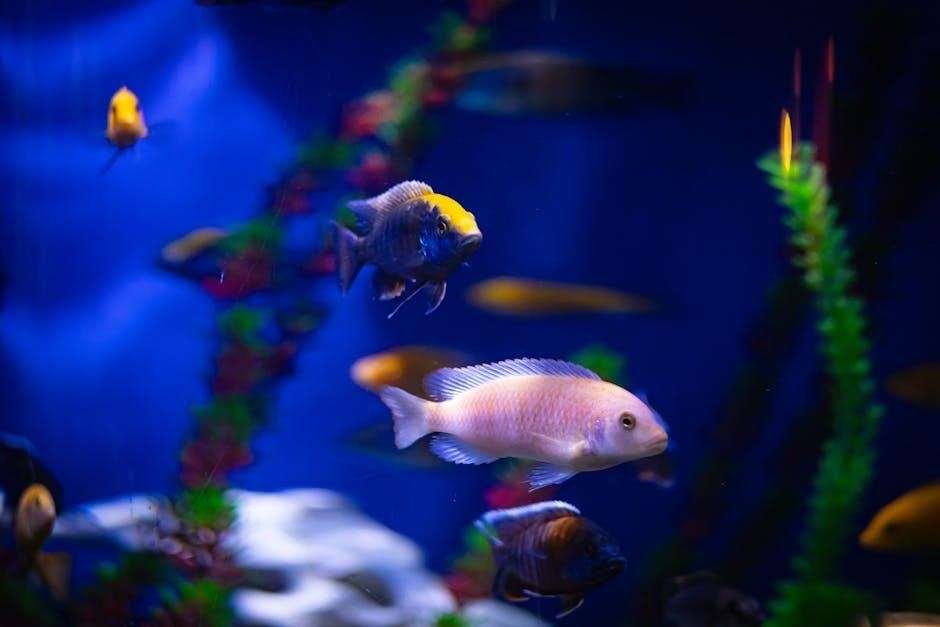
planted fish tank guide
Welcome to the world of planted fish tanks, where nature and beauty blend seamlessly! Discover how to create thriving underwater ecosystems that balance fish and plants perfectly.
Why You Need a Planted Aquarium: Benefits and Advantages
A planted aquarium enhances water quality by using live plants to absorb excess nutrients and produce oxygen, creating a healthier environment for fish. It also provides a natural food source and shelter for aquatic life. Planted tanks are visually stunning, adding beauty to any space. Additionally, they promote biodiversity and can be low-maintenance with proper setup. Observing a thriving underwater garden reduces stress and fosters a deeper connection to nature.
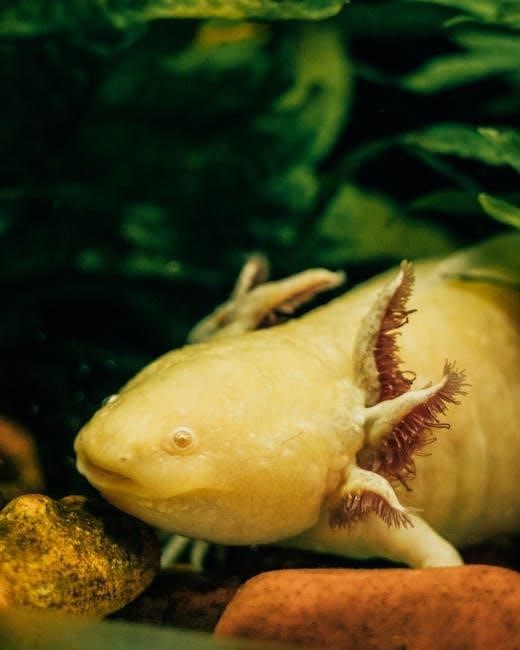
Types of Planted Tanks: Choosing the Right Style for You
Planted tanks come in various styles, each offering unique aesthetics. The Nature Style mimics natural ecosystems, while the Dutch Style focuses on vibrant plant arrangements. The Jungle Style creates a lush, dense environment, and the Iwagumi Style emphasizes minimalist rock and plant placements. Each style caters to different preferences, allowing aquarists to choose what suits their space and expertise best.
Setting Up Your Planted Fish Tank
Setting up a thriving planted tank involves careful planning and execution. Start by selecting the right equipment, substrate, and plants, then cycle the tank before introducing fish to ensure a healthy environment where both plants and fish can flourish together harmoniously.
Step-by-Step Guide to Setting Up Your Tank
Begin by selecting a tank size and style that fits your space and preferences. Next, layer the substrate, followed by soil or gravel, ensuring proper drainage. Add hardscape elements like rocks or driftwood for structure. Plant your chosen aquatic plants, starting with foreground species and moving to background. Fill the tank with dechlorinated water, then install equipment like lights and filters. Allow the tank to cycle for 2-3 weeks before introducing fish, ensuring a stable environment for all inhabitants to thrive.
Choosing the Right Tank Size and Dimensions
Selecting the right tank size is crucial for a thriving planted aquarium. A minimum tank size of 20 gallons is recommended for stability and ease of maintenance. Opt for longer tanks to provide ample swimming space for fish and better visual appeal. Avoid overly tall tanks, as they can be challenging to maintain and may limit plant growth. Proper dimensions ensure a balanced ecosystem and aesthetic appeal.
Preparation and Layering: Substrate, Soil, and Gravel
Start by adding a 1-2 inch layer of nutrient-rich soil, perfect for root development. Cap this with a layer of gravel to prevent soil disturbance. Use root tabs for plants requiring extra nutrients. Avoid garden soil to prevent contamination. This layered approach promotes healthy plant growth and maintains water clarity. Proper substrate preparation ensures a stable foundation for your aquatic ecosystem.
Water Preparation and Cycling: A Critical First Step
Dechlorinate water before adding it to your tank to remove harmful chemicals. Use a reliable water test kit to monitor ammonia, nitrite, and nitrate levels. Allow the tank to cycle for 2-4 weeks before introducing plants or fish. This natural process establishes beneficial bacteria, ensuring a healthy environment for your aquatic life to thrive.
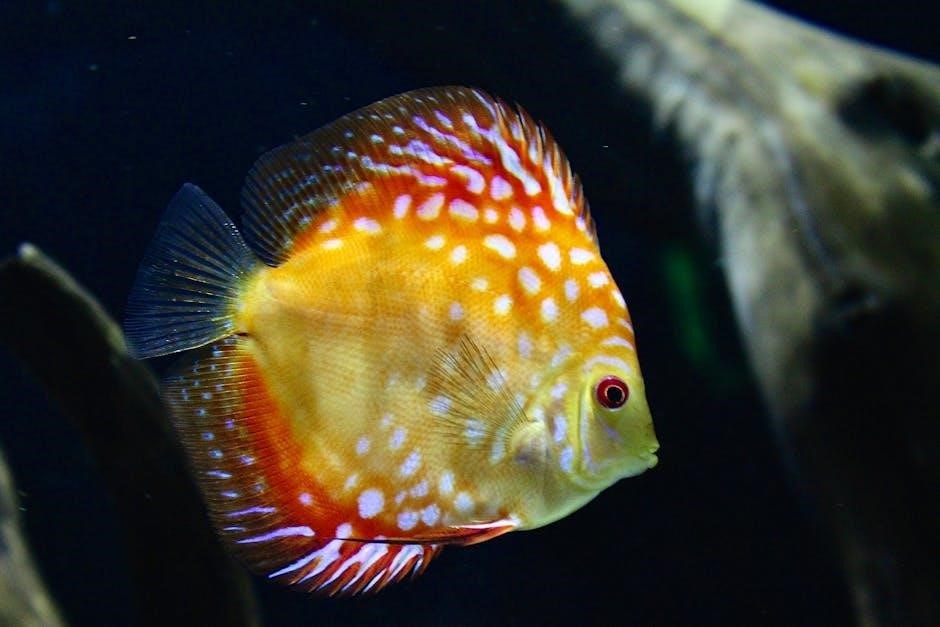
Plants for Your Aquarium
Explore the vibrant world of aquatic plants, from low-maintenance species like Java Moss to stunning Amazon Swords. Plants enhance water quality, provide shelter, and add natural beauty to your tank, creating a thriving ecosystem for fish and flora alike.
Popular Freshwater Plants for Beginners
Start your aquatic journey with easy-to-grow freshwater plants like Java Moss, Anacharis, and Amazon Swords. These hardy species thrive in various conditions, making them perfect for beginners. Java Moss carpets the tank floor, while Anacharis grows rapidly, helping maintain water clarity. Amazon Swords add striking beauty and provide shelter for small fish, creating a balanced and vibrant aquarium ecosystem.
How to Choose the Right Plants for Your Tank
Selecting the right plants involves considering tank size, lighting, and water conditions. Opt for plants that match your tank’s requirements, such as carpeting plants for foregrounds or tall species for backgrounds. Ensure compatibility with fish by choosing non-invasive, fish-friendly options. Consider growth rates and maintenance needs to create a balanced, thriving environment that complements your aquarium’s aesthetic and functional goals. Research and plan carefully for the best results.
Planting Techniques:Foreground, Midground, and Background
Foreground plants, like short carpeting species, create a lush base layer. Midground plants add depth with taller varieties, while background plants, such as large stems or leaves, provide a striking visual backdrop. Layering these zones creates a natural, balanced aquascape. Start planting in shallow water for easier placement, ensuring proper root growth and stability for each plant. This layered approach enhances both aesthetics and functionality, fostering a thriving ecosystem.
Equipment for a Thriving Planted Tank
Essential equipment includes high-quality lighting, a reliable CO2 system, and effective fertilizers. A good filter and proper substrate also support plant growth and water clarity. Invest wisely!
Lighting: Types, Duration, and Intensity
LED and T5/T8 lights are popular for planted tanks, offering balanced PAR levels. Maintain 6-8 hours of lighting daily, splitting into morning and evening periods to prevent algae growth. Adjust intensity based on plant type: low for carpeting plants, medium for midground, and high for background species. Avoid overlighting to ensure a healthy balance for both plants and fish.
CO2 Systems: Importance and Setup
A CO2 system is essential for thriving plant growth, enhancing photosynthesis, and preventing algae overgrowth. Maintain CO2 levels between 10-25 ppm, depending on plant species. Install a regulator, solenoid, and diffuser for precise control. Start with lower levels and gradually increase to avoid shocking fish. Proper setup ensures balanced plant growth and a healthy aquarium ecosystem.
Fertilizers: Choosing the Right Ones for Your Plants
Fertilizers provide essential nutrients like nitrogen, phosphorus, and potassium for plant growth. Use liquid fertilizers for water-column feeders and root tabs for plants with heavy root systems. Start with small doses and monitor plant response to avoid over-fertilizing, which can cause algae blooms. Balance is key to promoting healthy growth and maintaining a thriving ecosystem.
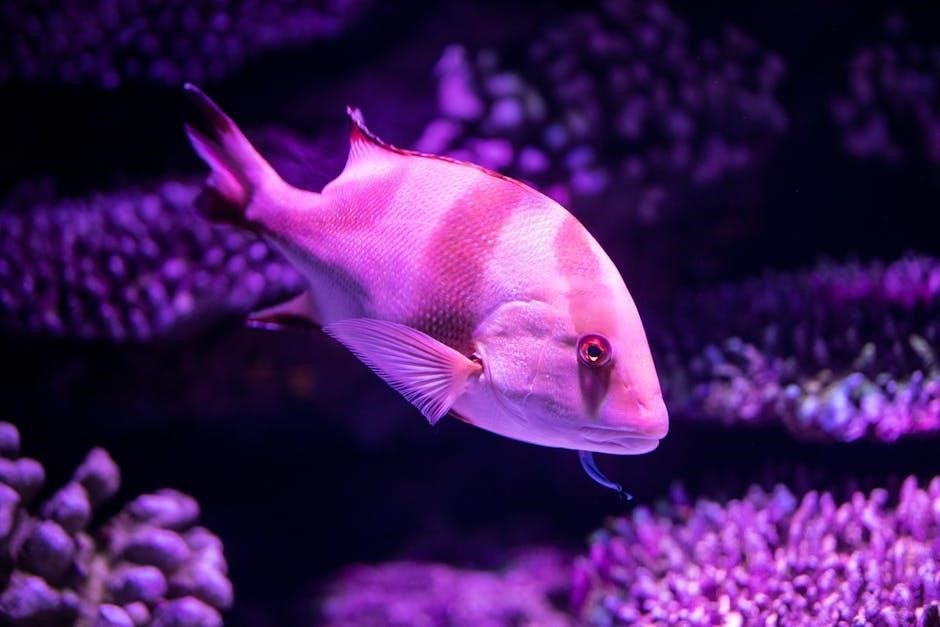
Aquascaping: Designing Your Tank
Aquascaping transforms your tank into a stunning underwater world. Use rocks, driftwood, and plants to create natural aesthetics. Balance hardscape and greenery for a visually pleasing environment.
Key Principles of Aquascaping
Aquascaping relies on balance, proportion, and harmony. Start with a focal point, use the rule of thirds, and ensure lighting highlights key elements. Mix textures and colors to avoid monotony. Maintain negative space for a natural look. Patience is crucial, as plants grow and evolve over time, requiring occasional adjustments to maintain aesthetic appeal.
Using Hardscape Elements: Rocks, Driftwood, and More
Rocks, driftwood, and other hardscape elements create structure and visual interest in your aquarium. Use rocks to form caves or divides, while driftwood adds natural beauty and hiding spots for fish. These elements enhance water flow and provide surfaces for plant attachment, creating a balanced and visually appealing underwater landscape.
Creating a Balanced and Visually Appealing Layout
A well-designed layout balances plants, hardscape, and open swimming space. Start with short plants in the foreground, taller ones in the back, and focal points like driftwood or rocks. Ensure fish have room to move while maintaining visual flow. This creates a harmonious, natural environment that enhances both beauty and functionality in your aquarium.
Maintenance and Care
Regular water changes, pruning plants, and monitoring water parameters are essential for a thriving tank. Consistent care ensures a healthy environment for both fish and plants.
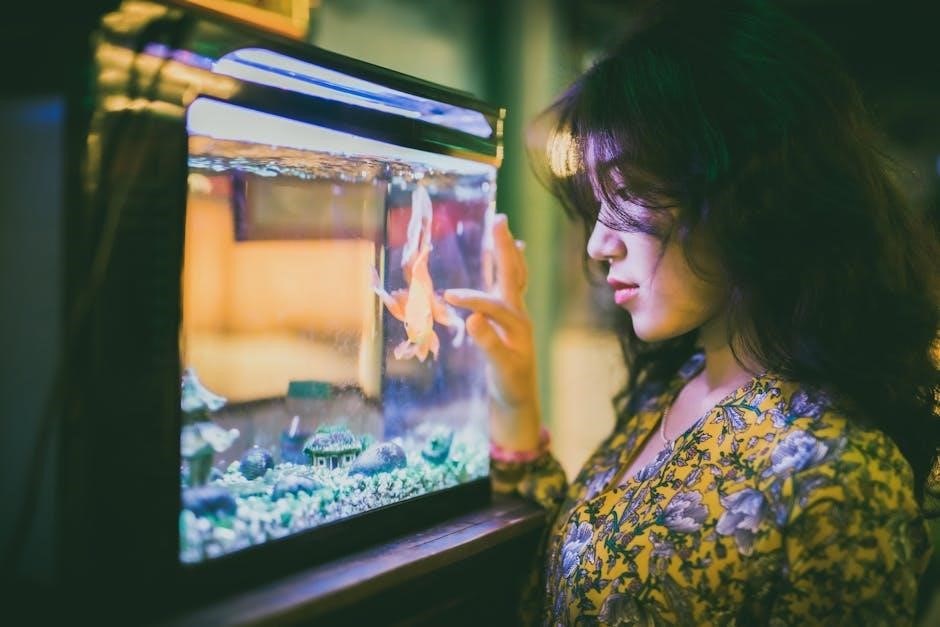
Regular Water Changes: Frequency and Tips
Regular water changes are crucial for a healthy planted tank. Aim for 25-50% weekly to maintain stability. Use a gravel vacuum to remove debris and test water parameters before replacing. Consistency is key to preventing shocks to plants and fish. Always use dechlorinated water to ensure a safe environment for your aquatic ecosystem.
Pruning and Trimming plants
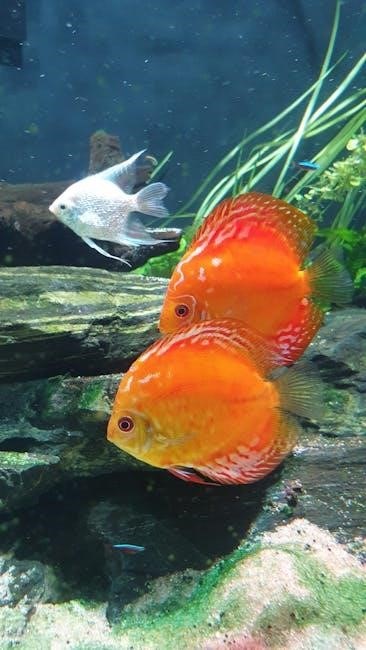
Regular pruning and trimming are essential to maintain plant health and aesthetic appeal. Use scissors or clippers to trim overgrown stems and remove dead leaves. This promotes healthy growth and prevents the tank from becoming overcrowded. Trim plants weekly or biweekly, depending on growth rates, to keep your aquarium balanced and visually stunning.
Monitoring Water Parameters and Adjustments
Regularly monitor water parameters like ammonia, nitrate, and CO2 levels to ensure a balanced ecosystem. Test water weekly and adjust as needed to maintain optimal conditions. Perform partial water changes to remove toxins and replenish essential nutrients. Adjust CO2 levels between 10-25 ppm to promote plant growth without harming fish. Consistent monitoring ensures a thriving, healthy aquarium environment.
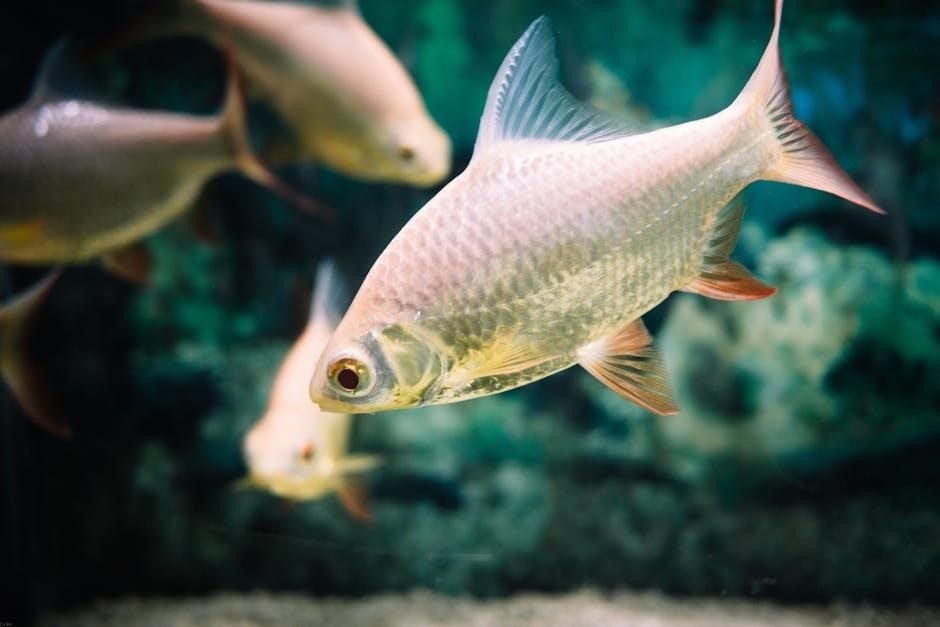
Fish Selection for Planted Tanks
Choose fish that thrive in planted environments, such as small, peaceful species like neon tetras or harlequin rasboras. Avoid large or aggressive fish that disturb plants or overcrowd the tank.
Best Fish Species for a Planted Aquarium
Neon tetras, harlequin rasboras, and dwarf gouramis are ideal for planted tanks. These peaceful, small fish thrive in lush environments and add vibrant color without disturbing plants. Avoid aggressive or large species that may damage vegetation or overcrowd the tank. Choose fish that complement your aquarium’s ecosystem, ensuring a harmonious balance between aquatic life and flora.
Stocking Levels: How Many Fish is Too Many
Avoid overstocking to maintain water quality and plant health. Stick to the “one inch of fish per gallon” rule, but consider adult sizes. Too many fish can lead to poor water conditions and stress. Start with a few small, peaceful species and monitor their impact before adding more. Overcrowding harms both fish and plants, so balance is key for a thriving ecosystem.
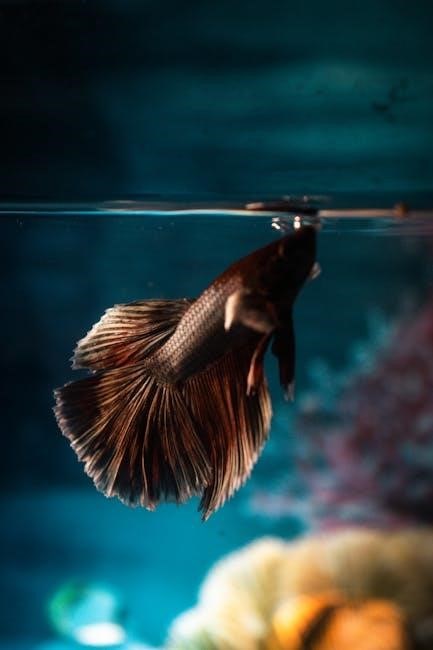
Introducing Fish to Your Planted Tank
Allow your tank to establish for 2-3 weeks before adding fish. Acclimate fish slowly to avoid shock. Start with small, peaceful species that complement your plants. Avoid overstocking and monitor water parameters closely. Introduce fish gradually to maintain balance and ensure a healthy ecosystem for both aquatic life and flora to thrive together harmoniously.
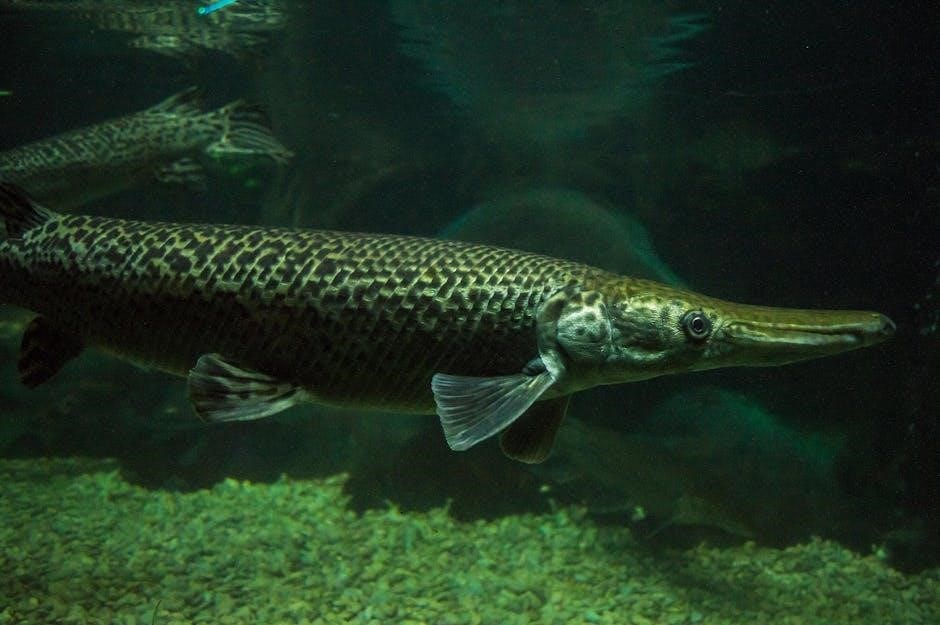
Troubleshooting Common Issues
Identify and address algae growth, plant health decline, or water quality issues promptly. Adjust CO2 levels, trim excess algae, and ensure proper water changes to maintain balance and clarity.
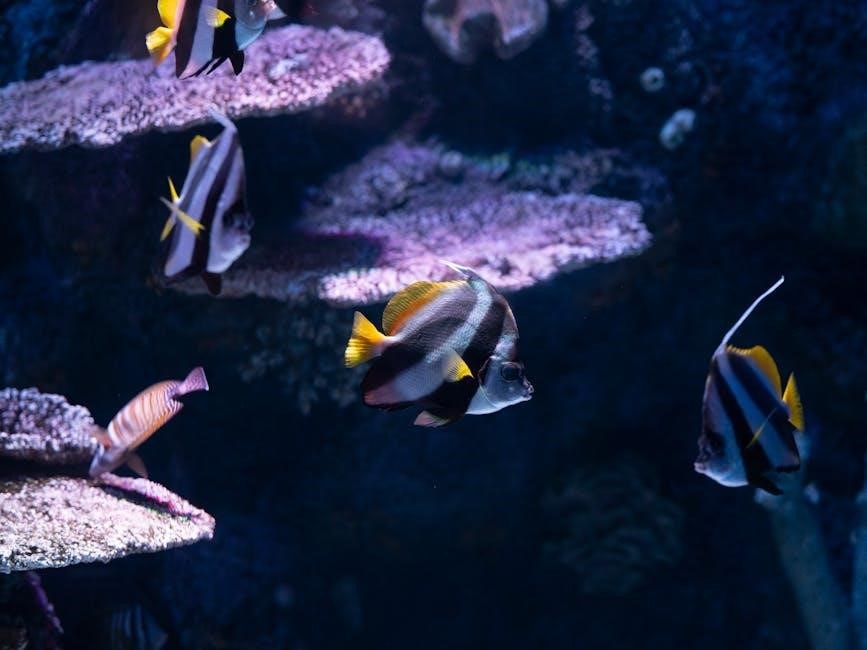
Algae Control: Causes and Solutions
Algae growth is often caused by excess light, nutrients, or unstable water parameters. To combat it, reduce lighting duration, maintain balanced fertilization, and introduce algae-eating organisms. Regular water changes and ensuring proper CO2 levels can also help prevent outbreaks. Monitor and adjust conditions to keep your tank algae-free and thriving.
Plant Health: Diagnosing and Treating Problems
Identify issues by observing leaf color, growth rate, and overall appearance. Yellowing leaves may indicate nutrient deficiencies, while curling leaves could signal underwatering or CO2 imbalances. Treat by adjusting lighting, fertilization, and water parameters. Regular pruning and ensuring proper water circulation can prevent decay and promote healthy growth. Address problems early to maintain a lush, thriving aquarium.
Water Quality Issues: Prevention and Cure
Maintaining optimal water quality is crucial for a thriving planted tank. Regular water changes (25-50% weekly) help prevent nutrient buildup. Monitor pH, ammonia, nitrite, and nitrate levels. Use reliable test kits and adjust parameters as needed. Install a high-quality filter and ensure proper water circulation. Addressing imbalances promptly prevents algae outbreaks and keeps fish and plants healthy and stress-free.
Future Trends and Expansion
Explore advanced techniques, innovative equipment, and sustainable practices. Discover emerging plant and fish species, pushing the boundaries of aquarist creativity and knowledge for a thriving aquatic world.
Advanced Techniques for Experienced Aquarists
Explore cutting-edge methods like advanced CO2 injection systems, precision nutrient dosing, and innovative aquascaping designs. Experienced aquarists can experiment with rare plant species, unique hardscape layouts, and automated water parameter controls. These techniques allow for greater creativity and precision, enabling the creation of stunning, self-sustaining ecosystems that showcase aquatic artistry at its finest.
Upgrading Your Tank: Bigger or Better Equipment
Consider upgrading to a larger tank for greater stability and space to showcase more plants and fish. Invest in advanced lighting systems, such as LED grow lights, for enhanced plant growth. Upgrade to a high-quality filter and precise CO2 injectors for optimal water conditions. Automation, like dosing pumps, can streamline maintenance. Better equipment ensures a thriving, visually stunning aquarium.
Exploring New Plant and Fish Species
Expand your aquarium’s diversity by experimenting with rare plant species like exotic mosses or vibrant stem plants. Introduce unique fish species that complement your tank’s ecosystem, such as dwarf cichlids or peaceful loaches. Research compatibility and care requirements to ensure harmony. This exploration enhances both beauty and biodiversity, making your aquarium a captivating underwater sanctuary.